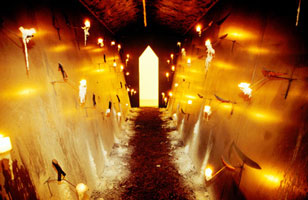| home |
| statement |
| work |
| articles |
| résumé |
| contact |

Tim Curtis
Elliot Smith Contemporary Art, St. Louis
Tim Curtis's recent exhibition at Elliot Smith Contemporary Art presented 11 new works that speak metaphorically about human separation from the forces of the natural world--and the loss of cultural ties once affirmed through ritual and myth. Often based on tree forms, his sculpture suggests processes of growth, decay, and regeneration, and conjures up the presence of mythic journeys and spiritual rebirth. Since 1992, boat-shaped sculptures have had a prominent place in his installations. Curtis likes to describe them as figurative images around which the themes of mourning and ascension are played out.
As symbols for the journey through life, or as mystical vessels sailed into the hereafter, boats have long served the purposes of art: Egyptian funerary paraphernalia, soul boats from Oceania, Thomas Cole's "The Voyage of Life" paintings, or the allusions to the netherworld which fill Richard Wagner's The Flying Dutchman express the kinds of symbolism Curtis wants his works to elicit. His earliest spirit boats rested on beds of rice or clay, or on sheaves of grass. Constructed out of basketlike frames which were charred to a velvety blackness, these boats seemed the afterimages of funeral pyres. At the entrance to his recent show, an untitled vessel was suspended from the ceiling. Floating in mid-air and surrounded by a cage of soldered-steel strips fashioned into the shape of an immense pod, the boat hovered at eye level. River rocks bound in twine dangled downward near the gallery floor, halting the vessel's flight into the spirit world.
Since 1992, boat-shaped sculptures have had a prominent place in his installations. Curtis likes to describe them as figurative images around which the themes of mourning and ascension are played out. As symbols for the journey through life, or as mystical vessels sailed into the hereafter, boats have long served the purposes of art: Egyptian funerary paraphernalia, soul boats from Oceania, Thomas Cole's "The Voyage of Life" paintings, or the allusions to the netherworld which fill Richard Wagner's The Flying Dutchman express the kinds of symbolism Curtis wants his works to elicit. His earliest spirit boats rested on beds of rice or clay, or on sheaves of grass. Constructed out of basketlike frames which were charred to a velvety blackness, these boats seemed the afterimages of funeral pyres. At the entrance to his recent show, an untitled vessel was suspended from the ceiling. Floating in mid-air and surrounded by a cage of soldered-steel strips fashioned into the shape of an immense pod, the boat hovered at eye level. River rocks bound in twine dangled downward near the gallery floor, halting the vessel's flight into the spirit world.
Curtis has an uncanny knack for exhibition design. By alternating floor, ceiling and wall pieces, he literally propelled the viewer around the installation's edges and across the center space of the gallery. His balancing act encouraged movement from one piece to another and made the visual experience of his works additive-each work contributing meaning to the next so that the whole gradually accumulated force and presence. Sections of three massive tree trunks occupied the installation's center. The interiors of these immense fragments had been carved away and replaced with sheets of hammered and folded steel. They exerted a mood that was at once both meditative and physical. Their scale and the labor-intensive fabrication needed to construct them ironically served a most ethereal subject, as they provided a vision of the path or passageway of the spirit. Tim Curtis is at his best in these abstract works.
In the closing section of the exhibition, a full-scale tunnel was fashioned out of sloping steel walls that were arched at the top and gradually tapered inward toward a floor covered with soil, dried leaves, and pine needles. Along both walls, Curtis placed rows of small votive candles, miniature boats and abstract representations of human figures. Cascades of glistening candle wax encrusted the walls. The quality of light as it flickered off the melted wax and polished steel created a glow that played strongly on the emotions. In the end, however, the work avoided maudlin sensibilities through the incredible clarity and power of the artist's meticulous craftsmanship.
Sculpture Magazine, October 1996